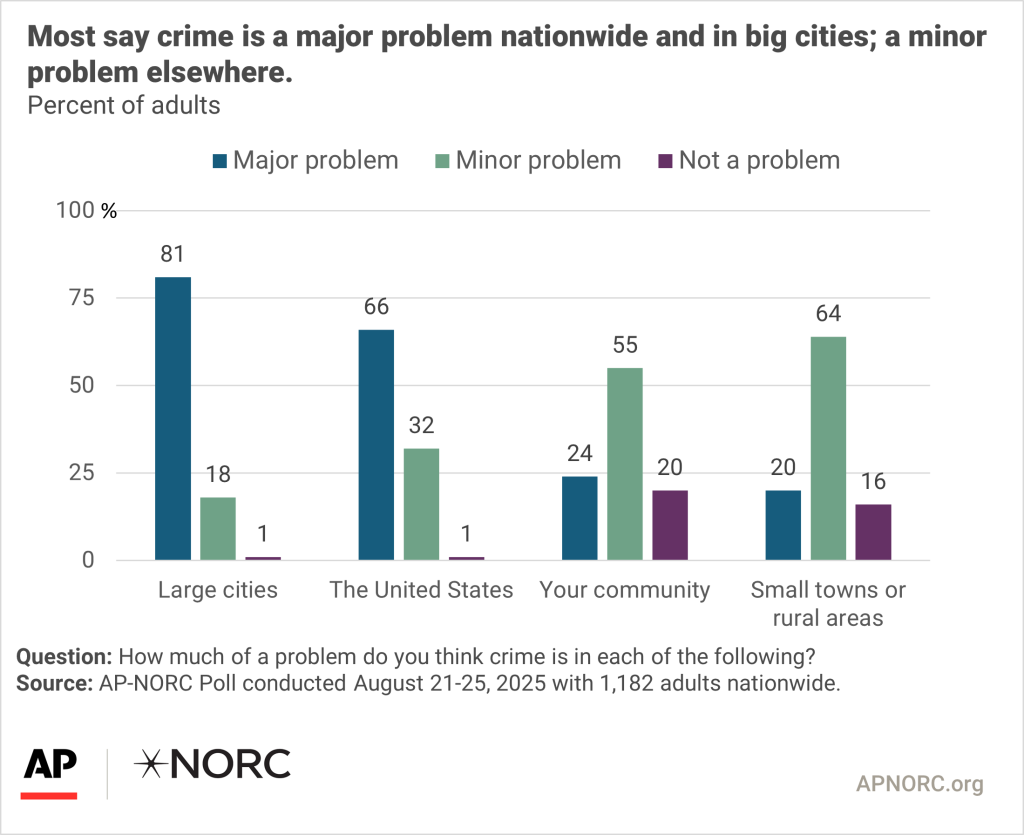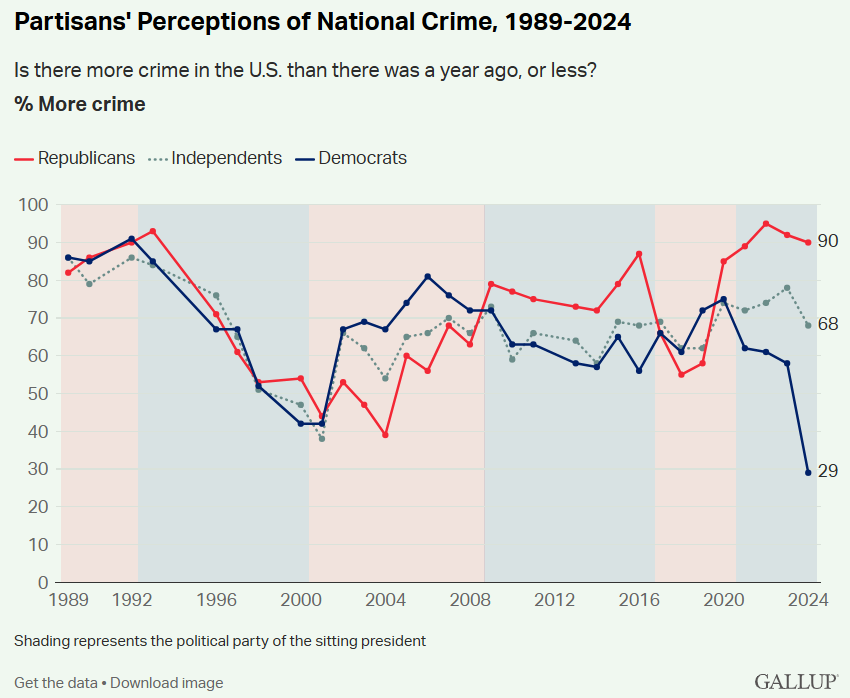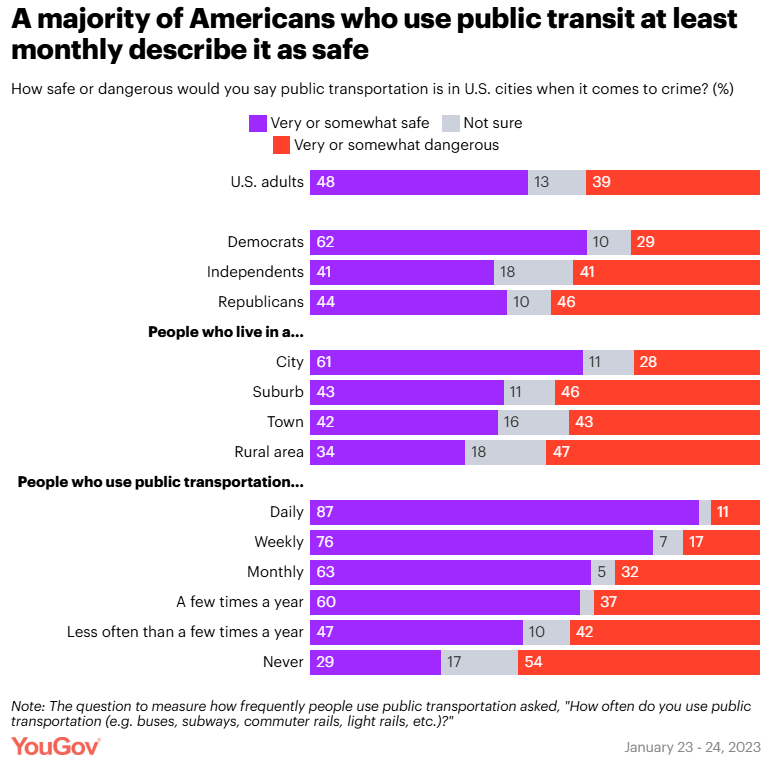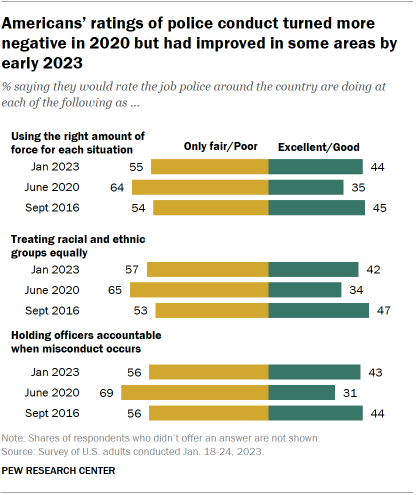What Americans Think About Crime and Public Safety
The first in a series of posts examining how the American public views various public policies and sociocultural issues.
In my decade-plus of conducting political analysis on American politics and voters, something I have routinely observed is what might be called a “false consensus bias,” which leads people to overestimate how common their own values and beliefs—or the most commonly held values and beliefs of their immediate peer group or community—actually are in the rest of society. I’ve seen this problem grow worse as more of American life has become fragmented and people have increasingly sorted themselves into ideological silos, both in the real world and online.
At TLP, we often write about how this kind of bias has led the Democratic Party astray, putting them on the wrong side of public opinion on key issues, at times without even realizing it. But many others fall victim to this faulty thinking too, and when they do, it can make it much more difficult for Americans to really understand the world around them or to find consensus on the best solutions for the country.
In light of this, we are launching a new series dedicated to parsing public opinion, in all its complexity and nuance, on several important topics, beginning with crime and public safety. More than a month into the Trump administration’s law enforcement crackdown in Washington, D.C., we wanted to know how Americans are thinking about his actions—and about these issues more broadly.
Perceptions and Concerns about Crime
Most Americans are concerned about crime today. According to an August AP-NORC survey, two-thirds see crime in the U.S. as a “major” problem. A 2024 Pew Research study also found that the share of Americans who said tackling crime should be a top priority for the president and Congress steadily grew every year between 2021 and 2024 among both Democrats and Republicans, with 58 percent overall agreeing last year. However, people’s perceptions about crime levels improved as well from 2023 to 2024, with the percent saying “there is more crime in the U.S. than one year ago” dropping from 77 percent to 64 percent.
Americans also tend to believe that crime in their local area is nowhere near as bad as it is at the national level. For example, as of this year, Gallup found that the share saying that crime is “extremely or very serious” nationally was nearly two-thirds (63 percent), but that same figure was just 17 percent when people were asked about the area where they live. Across community types, the population likeliest to see crime as both a serious and growing problem in the U.S. are those living in small towns and rural areas (though they are the least likely to view crime as serious at the local level).
AP-NORC presented similar findings: two-thirds (66 percent) think crime nationally is a “major problem,” while an astounding 81 percent say the same about big cities. But in their own communities? That figure is just 24 percent.
Of course, as with many issues today, there is a huge partisan divide on several of these questions. Gallup’s polling shows that from the late 1980s through the 1990s, Republicans’ and Democrats’ views on the trajectory of crime rates moved almost in tandem. At the turn of the century, this changed. Democrats during nearly every year of George Bush’s tenure believed there was more crime than in the previous year. In 2009, after Barack Obama was inaugurated, that dynamic was reversed, with Republicans believing the same for all eight years of his presidency. In 2017, this flipped once again.
Now, in Trump’s second term, perceptions about growing crime face their widest partisan gap on record: fully 90 percent of Republicans think it is worsening, while just 29 percent of Democrats—by far the lowest over the last three to four decades—say the same.
Essentially, perceptions about crime increasingly seem to hinge on one’s national and partisan considerations, such as personal political affiliation and the party in control of the White House.
Crime and Public Transit
The issue of safety on public transportation has moved to the center of the national discourse in recent years thanks to several high-profile incidents on trains. In a 2023 survey, YouGov found that a plurality (48 percent) of Americans believed public transit is “very or somewhat safe” compared to 39 percent who said it is dangerous. But answers varied widely at the group level. People who actually use public transit were far more likely to say it is safe than people who seldom or never use it. Among those who use it daily, for instance, a whopping 87 percent consider it a safe form of transportation compared to just 11 percent who think it’s dangerous. Similarly, those living in cities view public transit as far safer than those who live in rural areas.
However, combining “very” and “somewhat” into one category obfuscates a more complicated story. When YouGov breaks these out, a much larger share says public transportation is “somewhat” safe (34 percent) than “very” safe (14 percent). And certain groups are less likely than others to feel “very” safe, including women and seniors. So, while most people on net feel safer than not, those sentiments don’t necessarily indicate an absence of concerns or fears.
One helpful case study is Washington, D.C., the center of a national battle over crime, safety, and “law and order.” According to a May Washington Post poll, nearly two-thirds (64 percent) of Metrorail riders said that safety from crime is “excellent” or “good.” And while this was a notable uptick from 2024, when that figure was 57 percent, the results varied by demographic group. One of the more pronounced contrasts was between high- and low-income riders: three-quarters (74 percent) of riders who earn $200,000 or more reported feeling good about their safety while riding the Metro, a huge jump from the previous year when that number was just 59 percent. But among those who earn less than $50,000, a smaller 54 percent agreed.
Suffice it to say that while a majority of Americans do feel fairly safe on public transportation, many believe it could be safer, and not all riders share the same experiences.
Policing
A slight majority of Americans expresses confidence in policing, though this is down from its peak in 2004. Gallup data shows that back then nearly two-thirds (64 percent) of Americans said they had a “great deal/quite a lot” of confidence in police. Between 2007 and 2019, that number dropped but then remained fairly steady, averaging around 56 percent during that period. But since 2020, it has experienced another drop, hitting a nadir of 43 percent in 2023. As of last year, things had rebounded a bit, but still only barely over half (51 percent) expressed confidence.
As with crime overall, there is a partisan gap when it comes to policing, though it is not nearly as wide. In 2024, 62 percent of Republicans said they had a great deal of confidence in police compared to 45 percent of Democrats (and 49 percent of independents).
Interestingly, the gap in attitudes toward the police (as measured by Gallup) between white and black Americans has been narrowing since hitting a low point in 2022 due largely to improving sentiments among the latter population. For instance, between 2022 and 2024, the share of black Americans who said they had confidence in their local police force grew from 55 percent to 64 percent. Similarly, the percent saying they were satisfied with the relationship between their community and the police went from 59 percent to 64 percent. Expectations about fair treatment and respectful encounters with law enforcement also both grew more favorable. In fact, a 2024 study revealed that most black Americans prefer to maintain or increase local police presence and spending—even to a greater degree than non-black Americans.
But although the trendlines grow better for policing—especially relative to 2020—Americans still say there is room for improvement. According to Pew, majorities believe cops’ job performance is “only fair or poor” in three specific areas: using the right amount of force for each situation (55 percent), treating racial and ethnic groups equally (57 percent), and holding officers accountable for misconduct (56 percent).
Crime and the 2024 Election
Last year’s presidential election offered fresh data on how voters felt about crime and public safety. The AP VoteCast post-election survey showed that fully 77 percent of voters said they were either “very concerned” (44 percent) or “somewhat concerned” (33 percent) about crime, and across both categories, Trump won these voters over Harris, 55 to 43 percent. When asked which candidate they trusted more to handle crime, Trump again had the advantage, with 48 percent picking him against 39 percent who chose Harris.
A pre-election YouGov survey took a deeper dive into each side’s voters who reported feeling strongly about crime. They found that 19 percent of Harris voters and 45 percent of Trump voters ranked crime in their top three most important issues—but their reasons for caring about it differed widely. For Harris supporters, the primary crime-related issues they cared about included gun violence and racial disparities in the justice system, while Trump voters cared more about police funding and criminal sentencing.
Interestingly, the survey also found that across eight policies proposed by Harris, Trump voters supported five of them, including some related to gun safety, police accountability, and rehabilitation for former prisoners.1 By contrast, across eight Trump policies, Harris voters supported only one: mandatory minimums for people convicted of violent crimes.
Pew analysis from before President Biden’s withdrawal from the race similarly found that both Biden and Trump voters agreed on some criminal justice policies, including believing it is important for police to keep communities safe and treat people of all racial and ethnic groups equally. Trump voters were likelier to say it’s important to maintain public respect for police officers, while Biden voters disproportionately stressed the need to protect the rights of the accused, but majorities of each candidate’s supporters said both policies were important. And though Trump supporters were far likelier (81 percent) to believe that the justice system isn’t tough enough on criminals, fully 40 percent of Biden voters said the same, including nearly half of his Hispanic and Asian supporters.
In general, the median American appears to support middle-of-the-road policies governing everything from policing and gun safety to sentencing and racial profiling.
Trump’s actions in D.C.
The hottest topic in politics right now may be the Trump administration’s crackdown on crime in the nation’s capital, and the public’s opinions about it often depend on how poll questions are asked. The AP-NORC poll from a couple of weeks back garnered attention for showing that 55 percent of Americans find it “completely or somewhat acceptable” for the federal government to “use the U.S. military and National Guard to assist local police,” though the question did not clarify why those groups would be called up to aid law enforcement.
By contrast, a Quinnipiac poll released the same day showed that voters opposed Trump’s “decision to deploy the National Guard to Washington D.C. in an effort to reduce crime” by 15 points (56 to 41 percent). This included nearly two-to-one opposition by independents. YouGov asked a similarly worded question and found that 47 percent of Americans (including 45 percent of independents) opposed Trump’s actions in D.C. compared to just 34 percent who supported them.
Moreover, the AP-NORC poll found strong opposition to the federal government “taking control of local police departments”—something the Trump administration tried to do before the courts batted down the idea—with 55 percent of respondents against it versus just 32 percent supporting it. Even among Republicans, only a bare majority (51 percent) viewed the proposal favorably compared to 36 percent who did not (versus 81 percent who backed sending the military in to support local police).
In other words, many people are concerned about crime and willing to give the Trump administration some room to maneuver in pursuit of addressing it. But they want it done the right way—and so far many are not thrilled with the results.
Separate YouGov polling found substantial bipartisan support for several other Harris policies related to crime.









The above is very interesting. It feels like a variation of Biden's "we have the best economy in the world", (Americans are just too stupid to realize how good, they have it). Dems appear to be saying yet again, crime is not the issue, wrongful perception is the problem.
Much of crime does appear to be down, but ask any law student studying for the Bar Exam, how many different ways exist, to charge the exact same criminal fact pattern. In the blink of an eye, an attempted rape can become a simple assault. Attempting to break into a home, with residents inside, can be a serious attempted home invasion or a simple breaking and entering, depending on how it is charged. One is a felony, the other a misdemeanor. The options are endless. Many Blue city DAs no longer believe in incarceration anything but murder, so they always order the lesser offense charged.
Moreover, many former crimes have been, either technically or de facto, decriminalized. If thefts below $1000 are no longer a criminal violation, but a civil one, theft is going to drop like a rock. A city that stops charging drug felonies, to prevent deportations, appears to be a city with less drug offenses. Some jurisdictions have a mandate to always undercharge juvenile crime.
Finally, Dems seem to fail to grasp, the randomness of crime is often far more important to citizens, than actual numbers. Half the country recently watched a beautiful young woman, having fled a war zone, stabbed to death on NC public transport, like something out of a horror movie. She purposely does not call attention to herself, and yet is murdered from behind, with no interaction with her killer. His rap sheet is a mile long. Despite actual video, many news sites refuse to report the murder. If crime were really a rarity, wouldn't such a heinous offense be news, all new organizations would rush to report?
Branding public safety as a MAGA issue is not a winning strategy for Democrats. This precisely what the left has done in the aftermath of Charlotte.